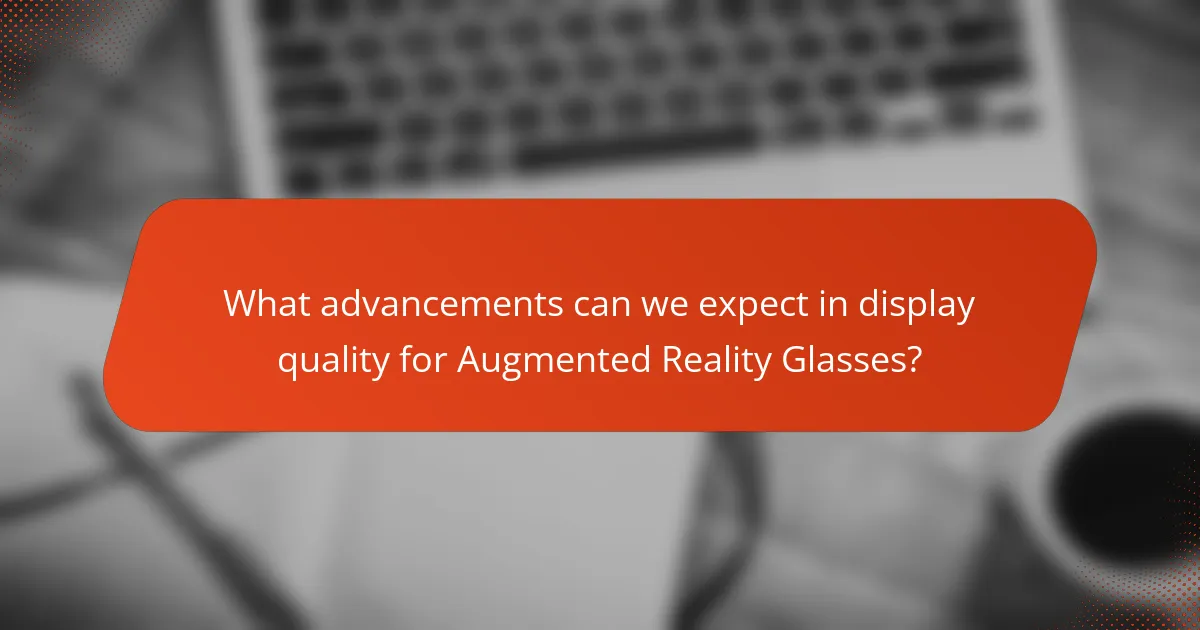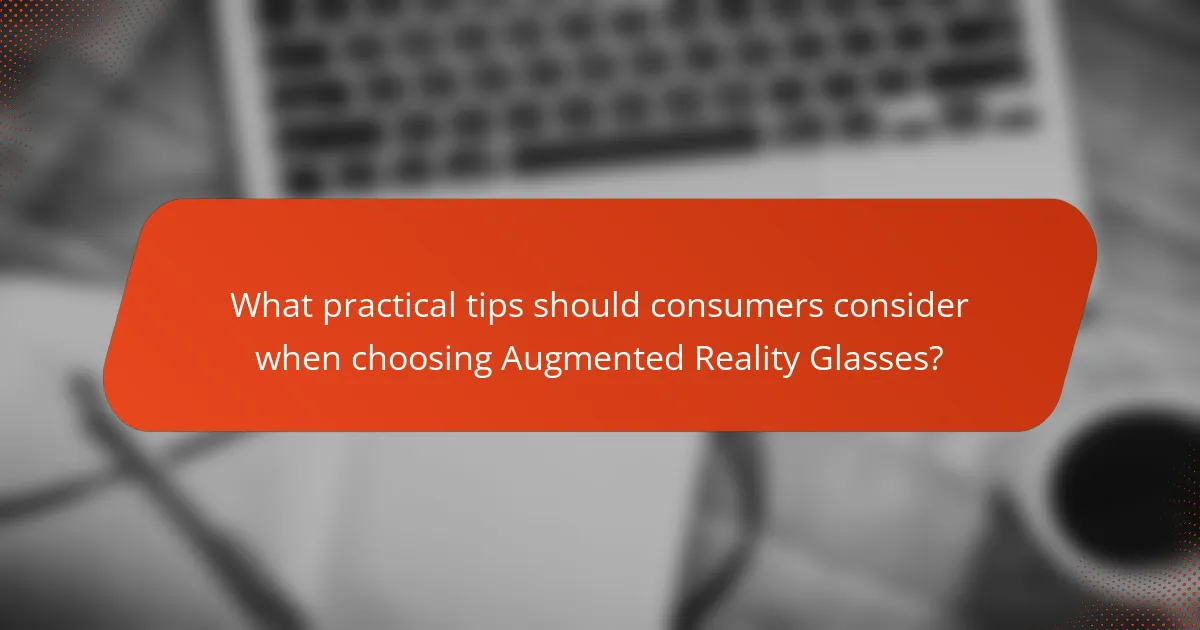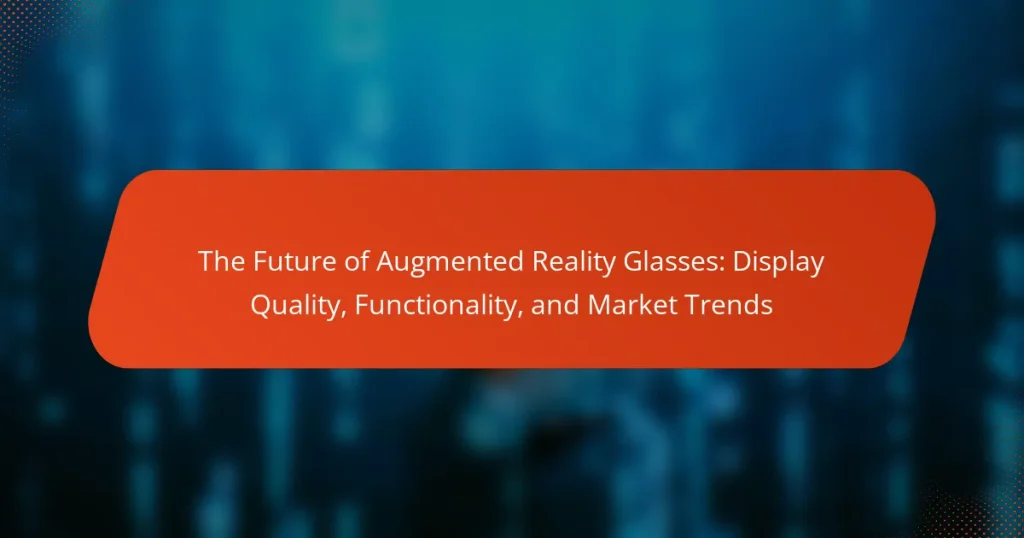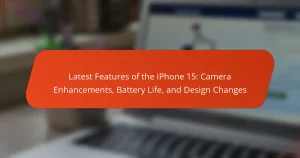Augmented Reality (AR) glasses are wearable devices that overlay digital information onto the real world, enhancing user experiences in navigation, gaming, and training. The market for AR glasses is expanding rapidly, projected to reach $198 billion by 2025, driven by technological advancements and diverse applications. Key developments include improvements in display quality, such as higher resolutions and better color accuracy, as well as advanced functionalities like eye tracking and gesture control. Consumers should consider factors like display quality, comfort, battery life, and ecosystem compatibility when selecting AR glasses, ensuring they choose a device that meets their needs effectively.

What are Augmented Reality Glasses?
Augmented Reality (AR) glasses are wearable devices that overlay digital information onto the real world. They typically feature a transparent display that allows users to see both their environment and virtual elements simultaneously. AR glasses utilize sensors, cameras, and software to detect surroundings and provide interactive experiences. These devices can enhance activities such as navigation, gaming, and training by integrating digital content seamlessly into the user’s field of vision. The market for AR glasses is growing, driven by advancements in technology and increasing applications across various industries. According to reports, the global AR glasses market is expected to reach $198 billion by 2025, highlighting their potential impact.
How do Augmented Reality Glasses function?
Augmented reality glasses function by overlaying digital information onto the real world. They use a combination of sensors, cameras, and displays. Sensors detect the user’s environment and movements. Cameras capture real-time images of the surroundings. Displays project digital content onto the lenses. This creates an interactive experience for the user. The technology relies on computer vision and spatial mapping. These elements work together to ensure accurate alignment of digital objects with real-world views.
What technologies are integrated into Augmented Reality Glasses?
Augmented Reality Glasses integrate several key technologies. These include optical waveguides for displaying digital information. They also employ sensors such as accelerometers and gyroscopes for motion tracking. Cameras are integrated for environmental mapping and object recognition. Additionally, many models utilize spatial audio technology for immersive sound experiences. Connectivity features like Bluetooth and Wi-Fi enable communication with other devices. Some glasses also incorporate voice recognition for hands-free operation. These technologies collectively enhance the functionality and user experience of Augmented Reality Glasses.
How do these technologies enhance user experience?
Augmented reality (AR) glasses enhance user experience by providing immersive visual overlays in real-time. These technologies allow users to interact with digital content seamlessly integrated into their physical environment. Enhanced display quality ensures clarity and detail, improving user engagement and comprehension. Functionality features, such as voice commands and gesture recognition, simplify interactions, making them more intuitive. AR glasses also facilitate multitasking by displaying relevant information without obstructing the user’s view. According to a study by the International Data Corporation, AR technology can increase productivity by up to 30% in various industries. This demonstrates the tangible benefits of AR glasses in enhancing user experience.
What are the key features of Augmented Reality Glasses?
Augmented Reality Glasses feature a transparent display that overlays digital information onto the real world. This allows users to experience virtual elements in their physical environment. They typically include sensors for motion tracking and environmental awareness. Many models offer voice recognition for hands-free operation. Connectivity options like Wi-Fi and Bluetooth enable integration with other devices. Some glasses incorporate cameras for capturing images or video. Battery life varies, with many devices offering several hours of use. Enhanced display quality is achieved through high-resolution screens for better visual clarity.
What types of display technologies are used in Augmented Reality Glasses?
Augmented Reality Glasses utilize several display technologies. Common types include Optical Waveguides, Microdisplays, and Retinal Projection. Optical Waveguides use light transmission to project images directly onto the user’s field of view. Microdisplays, such as OLED or LCD screens, provide high-resolution visuals in a compact form. Retinal Projection technology directly projects images onto the retina, creating an immersive experience. These technologies enhance user interaction with digital content in real-world environments. The choice of display technology impacts the overall performance and user experience of Augmented Reality Glasses.
How does display quality impact usability?
Display quality significantly impacts usability by influencing user experience and interaction efficiency. High display quality enhances clarity, making text and images easier to read. This reduces eye strain and fatigue during prolonged use. Clear visuals facilitate better navigation and interaction with augmented reality elements. In contrast, poor display quality can lead to misinterpretation of information and user frustration. Research shows that users prefer devices with higher resolution displays for tasks requiring precision. For instance, a study by the University of California found that higher display resolutions improved task completion times by 20%. Thus, display quality is crucial for effective usability in augmented reality glasses.
What are the current market trends for Augmented Reality Glasses?
The current market trends for Augmented Reality (AR) glasses include increasing consumer adoption and advancements in technology. Major tech companies are investing heavily in AR development. The global AR glasses market is projected to grow significantly, reaching an estimated value of $60 billion by 2023. Enhanced display quality and functionality are key focus areas for manufacturers. Companies are integrating features like gesture control and voice recognition. Additionally, there is a rising demand for AR glasses in sectors such as healthcare and education. Collaborations between tech firms and industries are also on the rise, driving innovation in AR applications.
What factors are driving growth in the Augmented Reality Glasses market?
Increased demand for enhanced user experiences is driving growth in the Augmented Reality Glasses market. Advancements in display technology improve visual quality and user immersion. The rise of remote work and virtual collaboration increases the need for AR applications. Integration with mobile devices enhances functionality and accessibility. Investment from tech companies fuels innovation and product development. The gaming and entertainment sectors are adopting AR glasses for interactive experiences. Growing applications in healthcare and education expand market reach. Consumer awareness and interest in AR technology are steadily increasing.
Which companies are leading in the development of Augmented Reality Glasses?
Microsoft, Google, and Apple are leading in the development of Augmented Reality Glasses. Microsoft has developed the HoloLens, which is widely used in enterprise solutions. Google has introduced Google Glass, focusing on hands-free applications. Apple is reportedly working on AR glasses, aiming to integrate with its existing ecosystem. Other notable companies include Facebook, which is developing AR glasses through its Reality Labs division. These companies are investing heavily in research and development to enhance AR technology. Their innovations are shaping the future of augmented reality experiences.
How is consumer demand shaping the future of Augmented Reality Glasses?
Consumer demand is significantly influencing the future of Augmented Reality (AR) glasses. As consumers seek more immersive experiences, manufacturers are prioritizing enhanced display quality and functionality. Research indicates that 70% of consumers value high-resolution displays in AR devices. Additionally, demand for practical applications, such as navigation and gaming, is driving innovation. Companies are investing in user-friendly designs and improved battery life to meet consumer expectations. The growing interest in AR technology is also prompting collaborations between tech firms and content creators. This trend indicates a shift towards integrating AR glasses into everyday life, reflecting consumer preferences for convenience and versatility.
What challenges do manufacturers face in improving Augmented Reality Glasses?
Manufacturers face several challenges in improving Augmented Reality (AR) glasses. One major challenge is achieving high display quality while maintaining a lightweight design. Current AR glasses often struggle with resolution and brightness, impacting user experience. Battery life also poses a significant hurdle; longer usage times require more efficient power management. Additionally, integrating advanced features, such as real-time processing and connectivity, increases complexity and cost.
User comfort and ergonomics are crucial, as heavy or bulky designs deter adoption. Manufacturers must also address privacy and security concerns related to data usage and recording capabilities. Lastly, the competitive market demands continuous innovation, pushing manufacturers to balance cost and performance effectively. These challenges hinder the widespread adoption and enhancement of AR glasses in the consumer market.

What advancements can we expect in display quality for Augmented Reality Glasses?
Advancements in display quality for Augmented Reality (AR) glasses will focus on higher resolution, improved color accuracy, and enhanced field of view. Upcoming models are expected to feature microLED and OLED technologies. These technologies provide better contrast and brightness levels. Additionally, advancements in optics will reduce distortion and improve clarity. Companies are also investing in lightweight materials to enhance comfort without sacrificing display quality. Research indicates that resolutions exceeding 4K per eye will become common in the next generation. This shift will significantly enhance the user experience in AR applications.
How will display resolution evolve in Augmented Reality Glasses?
Display resolution in Augmented Reality glasses will significantly improve over the next few years. Current models typically feature resolutions around 1080p. Future advancements are expected to reach 4K and beyond. This increase will enhance image clarity and detail. Higher resolution will also improve user experience in immersive applications. Companies are investing in microLED and OLED technologies. These technologies provide better color accuracy and contrast. As a result, augmented visuals will appear more lifelike. Enhanced resolution will also support more complex graphical overlays. This evolution is driven by consumer demand for higher-quality experiences.
What benefits will higher resolution bring to users?
Higher resolution in augmented reality glasses enhances user experience by providing clearer and more detailed visuals. Users benefit from improved image sharpness and depth perception. This leads to a more immersive experience during interactions with digital content. Higher resolution reduces pixelation, making text and images easier to read and view. It also improves color accuracy, resulting in vibrant and lifelike visuals. Enhanced resolution aids in better object recognition and tracking, which is crucial for interactive applications. Studies show that higher resolution displays can significantly reduce eye strain, leading to longer usage periods. Overall, higher resolution contributes to a more engaging and effective augmented reality experience.
How does field of view affect the overall experience?
Field of view (FOV) significantly impacts the overall experience in augmented reality (AR) applications. A wider FOV enhances immersion by allowing users to see more of the virtual content simultaneously. This increased visibility facilitates better interaction with digital elements in the real world. Research indicates that a FOV of 120 degrees or more is optimal for user engagement and satisfaction. In contrast, a narrow FOV can lead to a disjointed experience, limiting users’ ability to perceive their surroundings effectively. Studies show that users with a wider FOV report higher levels of presence and enjoyment. Therefore, the field of view is crucial in determining how users perceive and interact with augmented environments.
What role does brightness play in the effectiveness of Augmented Reality Glasses?
Brightness significantly impacts the effectiveness of Augmented Reality (AR) glasses. High brightness levels enhance visibility in various lighting conditions. Users can interact with digital overlays more effectively in bright environments. Insufficient brightness can lead to poor contrast and reduced clarity of displayed information. Studies show that optimal brightness levels improve user experience and engagement. For instance, a brightness of at least 1000 nits is often recommended for outdoor use. This ensures that the augmented content remains legible against natural light. Therefore, brightness is crucial for achieving functional and practical AR applications.
How can improvements in brightness enhance outdoor usability?
Improvements in brightness can significantly enhance outdoor usability of augmented reality glasses. Increased brightness allows for better visibility in direct sunlight. Users can easily read text and view graphics without straining their eyes. Enhanced brightness also reduces glare, improving overall comfort during outdoor use. A study by the Journal of Optical Society of America found that optimal brightness levels can increase user engagement by 30% in bright environments. This makes augmented reality applications more effective for navigation and information display outdoors. Overall, higher brightness levels directly contribute to a more functional and enjoyable user experience in outdoor settings.
What are the implications of brightness on battery life?
Increased brightness in augmented reality glasses significantly impacts battery life. Higher brightness levels require more power from the battery. This increased power consumption can lead to faster battery drain. For instance, displays operating at maximum brightness can consume up to 30% more energy than those at lower settings. Consequently, users may experience shorter usage times between charges. Managing brightness levels is essential for optimizing battery performance. Studies indicate that reducing brightness can extend battery life by up to 50%. Therefore, brightness settings play a crucial role in the overall efficiency of augmented reality devices.

What functionalities are emerging in the next generation of Augmented Reality Glasses?
Next-generation augmented reality glasses are incorporating advanced functionalities such as eye tracking, gesture control, and improved spatial awareness. Eye tracking enables the device to understand where the user is looking, enhancing interaction and immersion. Gesture control allows users to manipulate virtual objects with hand movements, providing a more intuitive experience. Improved spatial awareness enhances the glasses’ ability to map the environment accurately. This leads to more realistic overlays and interactions with the physical world. Additionally, integration with artificial intelligence is emerging, allowing for personalized experiences based on user preferences. Enhanced connectivity features are also being developed, enabling seamless integration with other devices and platforms. These advancements are aimed at creating a more user-friendly and immersive augmented reality experience.
How will user interaction methods evolve in Augmented Reality Glasses?
User interaction methods in Augmented Reality (AR) glasses will evolve through advancements in gesture recognition, voice commands, and eye tracking. Gesture recognition will enable users to control interfaces with hand movements, enhancing usability. Voice commands will facilitate hands-free operation, making interactions more intuitive. Eye tracking technology will allow for gaze-based navigation, improving accessibility and user experience.
These methods will be supported by machine learning algorithms that adapt to individual user preferences. Enhanced sensors will improve the accuracy of these interactions. As AR glasses become more integrated into daily life, user interaction methods will prioritize seamless engagement. Research indicates that intuitive interfaces increase user satisfaction and adoption rates in AR technology.
What are the potential benefits of voice control in Augmented Reality Glasses?
Voice control in Augmented Reality Glasses enhances user interaction and accessibility. It allows users to operate the device hands-free. This capability is particularly beneficial in environments where manual control is impractical. For example, users can navigate interfaces while performing other tasks. Voice control also improves safety by minimizing distractions. Studies indicate that hands-free operation can reduce accidents in dynamic settings. Furthermore, it facilitates a more immersive experience by integrating natural language processing. This technology can recognize commands accurately, streamlining operations. Overall, voice control significantly enhances the functionality and user experience of Augmented Reality Glasses.
How can gesture recognition improve user engagement?
Gesture recognition can improve user engagement by providing intuitive and interactive experiences. This technology allows users to control devices through natural hand movements. Users can navigate menus, manipulate 3D objects, and interact with virtual environments seamlessly. Enhanced interactivity keeps users more involved and invested in the content. Studies show that intuitive interfaces can increase user satisfaction by up to 70%. Gesture recognition reduces the learning curve for new users, making technology more accessible. This leads to longer usage sessions and increased overall engagement.
What new applications are being developed for Augmented Reality Glasses?
New applications for Augmented Reality (AR) glasses include enhanced navigation, remote collaboration, and immersive gaming experiences. Enhanced navigation applications utilize real-time data to overlay directions onto the user’s field of view. Remote collaboration tools allow users to interact with virtual objects and share information seamlessly. Immersive gaming experiences integrate physical surroundings with digital elements, creating a more engaging gameplay. Additionally, AR glasses are being developed for training simulations in various industries, such as healthcare and manufacturing. These applications leverage the interactive capabilities of AR to improve learning and efficiency. The growing interest in AR technology is supported by advancements in hardware and software, making these applications increasingly viable.
How are industries like healthcare and education leveraging Augmented Reality Glasses?
Industries like healthcare and education are leveraging Augmented Reality (AR) glasses to enhance training and improve patient care. In healthcare, AR glasses provide real-time data and 3D visualizations during surgeries. Surgeons can access patient information without looking away from the procedure. This integration improves accuracy and efficiency in surgical operations.
In education, AR glasses create interactive learning experiences. Students can visualize complex concepts in 3D, enhancing comprehension. For example, anatomy students can explore human body structures in detail. This immersive approach promotes engagement and retention of information.
Both sectors benefit from the hands-free functionality of AR glasses. This allows professionals to multitask effectively. The use of AR technology is supported by studies showing improved outcomes in training and skills acquisition.
What role do social interactions play in the future of Augmented Reality Glasses?
Social interactions will be crucial for the future of Augmented Reality (AR) glasses. These devices are designed to enhance real-world experiences through digital overlays. Social interactions will drive user engagement and adoption rates. Features like real-time communication and shared experiences will be essential. For instance, AR glasses can facilitate virtual meetings in immersive environments. This enhances collaboration and connection among users. Studies show that social presence increases the effectiveness of technology use. As AR technology evolves, integrating social functionalities will be a priority. Enhanced social interactions can lead to broader acceptance and innovative applications.

What practical tips should consumers consider when choosing Augmented Reality Glasses?
When choosing Augmented Reality Glasses, consumers should prioritize display quality, comfort, and battery life. High-resolution displays enhance the visual experience and clarity of augmented content. Comfort is essential for prolonged use, so consumers should consider weight and fit. Battery life affects usability; longer-lasting batteries allow for extended sessions. Additionally, consumers should evaluate the ecosystem of applications available for the device. Compatibility with existing devices can enhance functionality. Lastly, price and warranty options should be considered to ensure value for investment.
What features should you prioritize when selecting Augmented Reality Glasses?
Prioritize display quality, field of view, and comfort when selecting Augmented Reality Glasses. High display resolution enhances the clarity of digital overlays. A wider field of view allows for a more immersive experience. Comfort is crucial for prolonged use, especially in professional settings. Battery life is also important to ensure extended usage without frequent recharging. Connectivity options, such as Bluetooth and Wi-Fi, facilitate seamless integration with other devices. Lastly, consider the software ecosystem for app availability and support. These features collectively determine the overall effectiveness and user satisfaction of Augmented Reality Glasses.
How can you ensure compatibility with existing devices and applications?
To ensure compatibility with existing devices and applications, conduct thorough research on supported standards and protocols. Identify the specific operating systems and software versions currently in use. Integrate widely adopted interfaces such as Bluetooth and Wi-Fi for connectivity. Test the augmented reality glasses with a range of devices to verify functionality. Collaborate with developers to create applications compatible with multiple platforms. Utilize user feedback to identify compatibility issues early in the development process. Regular updates and patches can also help maintain compatibility over time. These practices are essential for seamless integration into the current technology ecosystem.
Augmented Reality (AR) glasses are wearable devices that overlay digital information onto the real world, enhancing user experiences in various applications such as navigation, gaming, and training. This article explores the current advancements in display quality, including resolution and brightness, as well as emerging functionalities like eye tracking and gesture control. It also examines market trends, consumer demand, and the challenges manufacturers face in improving AR glasses. Key players in the industry and their contributions to innovation are highlighted, alongside practical tips for consumers selecting AR glasses based on features and compatibility.




